Intern Experience at Lyft
[

Press enter or click to view image in full size

Written by Morteza Taiebat and Han Gong at Lyft.
Introduction
This post is authored by two current Lyft Data Scientists, Morteza Taiebat and Han Gong, who both began their journeys at the company as interns. They share their experiences leading up to their internships, the work they did while at Lyft, and what ultimately motivated them to return as full-time employees.
Whether you’re a prospective intern, a new hire, a candidate in the interview process, or simply curious about life at Lyft, this post offers insights into what it’s like to grow your career here.
Story from Morteza Taiebat
My journey at Lyft began through the EDF Climate Corps program, which places fellows in top organizations through a rigorous technical assessment process. Coming from an academic background, my research focused on studying the impacts of emerging transportation trends like automation, electrification, and shared mobility on travel behavior and sustainability outcomes. Joining Lyft gave me the opportunity to apply my expertise in a way that aligned perfectly with my passion for sustainability and shaping the future of transportation.
Team at Lyft
I joined Lyft’s Sustainability team in May 2020, around the time the company began outlining its vision and strategy to scale electric vehicle adoption across the platform. During my internship, I focused on building causal models to assess EV suitability and impact on driver productivity. This involved evaluating which types of driving patterns and operational contexts were most suited for EV adoption, in order to maximize driver benefits and emissions reductions. I assessed EV suitability based on factors like driving patterns, cost savings, and charging infrastructure availability, while also analyzing how EV adoption influenced driver engagement. By leveraging these models, we were able to quantify the impact of EV conversion on driver productivity and inform strategies for sustainable adoption across the different lines of business on the Lyft platform.
Intern Project
I focused on analyzing Driver-Hour (DH), Lyft’s preferred metric for measuring driver productivity, and on understanding the causal impact of EV conversion on this metric. To evaluate the effect of EV adoption on DH, I developed a difference-in-differences (DiD) model that compared changes in driver productivity before and after EV conversion. This quasi-experimental design contrasted the productivity trends of drivers who switched to EVs (treatment group) with those who continued using internal combustion engine vehicles (control group).
The DiD design hinged on the comparison between two groups over a specified pre and post conversion period:
- Treatment Group: Drivers who switched to EVs in the specific past X months.
- Control Group: Drivers who continued using gas-powered vehicles.
The equation at the heart of this model was:
Press enter or click to view image in full size

Press enter or click to view image in full size

Schematic representation of difference-in-differences (DiD) approach for analysis of EV conversion effect on driver productivity
A major challenge was understanding driver behavior. Many drivers on the Lyft platform are app-switchers, meaning they drive on multiple rideshare or delivery platforms. This limited our visibility into their complete driving patterns. To address this, I worked on integrating third-party data and making assumptions based on observable patterns on the Lyft platform. We also faced the issue of limited access to home charging, which affects drivers’ ability to make EVs viable for daily use. By incorporating projections of public charging station growth, we were able to better understand future feasibility for drivers.
This model became the backbone for identifying driver segments and usage patterns associated with successful EV transitions that minimize productivity disruptions, helping inform outreach strategies and support Lyft’s long-term sustainability goals.
Returning to Lyft
One of the things I appreciated most during my internship at Lyft was the culture of collaboration and focus on real impact. Everything in the rideshare space can be turned into a math problem, but the key is knowing which problems are worth solving. The work pushes you to think practically — what’s going to move the needle the most? That mindset stuck with me. I found myself applying the 80/20 rule constantly: 80% of the results come from focusing on the most impactful 20% of the efforts.
During my time on the Sustainability team, for example, we were exploring how EV adoption affected the driver experience. There were several analytical paths we could’ve taken — modeling charging downtime, emissions savings, changes in vehicle maintenance costs — but I chose to prioritize earnings impact, since that’s what drivers cared about most and what would influence policy decisions the fastest. That choice paid off: the work shaped internal strategy and was later published in a respected journal. It was one of those moments that made me realize how data science, when focused and well-scoped, can lead to real-world change.
Unlike academic research, where refining a problem can take unlimited time, at Lyft the focus is on building solutions that deliver meaningful results quickly, and then improving on them over time. That practical, fast-moving environment was a big part of what drew me back. After completing my fellowship, I rejoined the Sustainability team in 2021 and continued the work I’d started as an intern. Later, as Lyft formalized its EV team, I had the chance to interview for a full-time data science role and became Lyft’s first EV Data Scientist — a milestone that was incredibly fulfilling. Transitioning into the Algorithms archetype and eventually joining the Marketplace team deepened my understanding of the rideshare landscape. These steps have paved the way for my continued growth, as I tackle an ever-widening range of challenges in a dynamic, two-sided marketplace.
Advice for Future Interns/Employees
For those coming from an academic background, I recommend learning early how to balance execution speed with quality — a skill that’s not always emphasized in academia. Be proactive in seeking mentorship and take full ownership of your projects. The transition from intern to full-time data scientist has been a journey of continuous growth and learning. Whether it’s shaping EV adoption strategies or optimizing marketplace algorithms, working at Lyft has enabled me to engage with projects that truly align with my passions and deliver tangible impact. If I could go back, I would focus on building partnerships with industry leaders and attending more conferences to better understand the challenges they face, and to invest in my skills accordingly.
If you’re considering an internship at Lyft, I encourage you to go for it — there’s no better place to learn and make a difference!